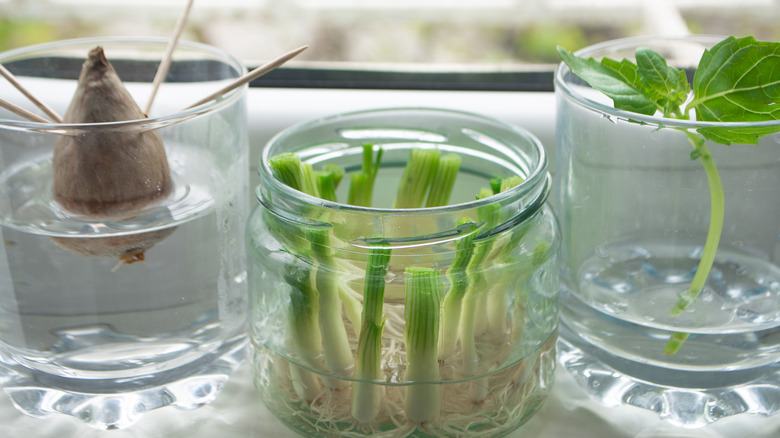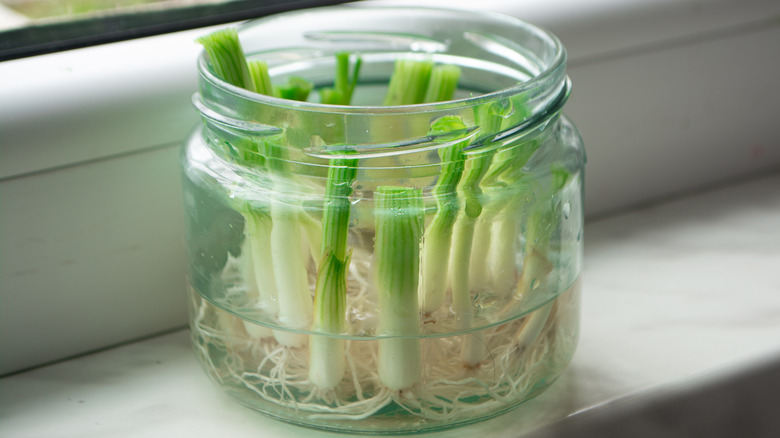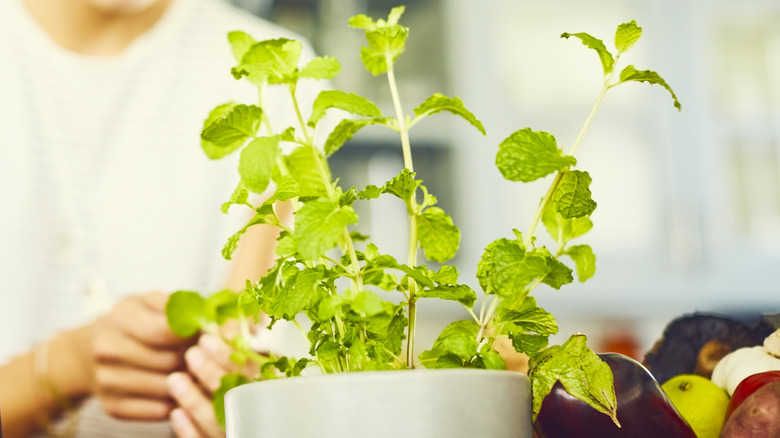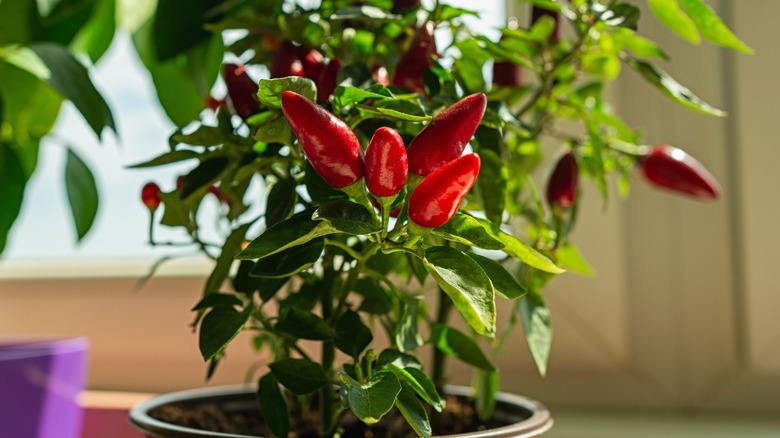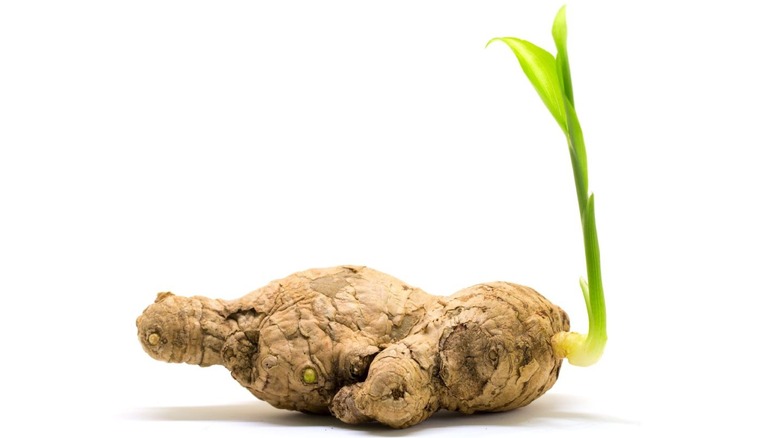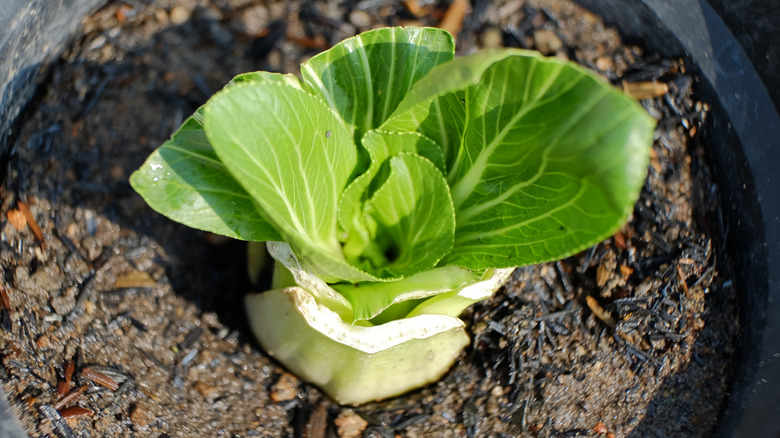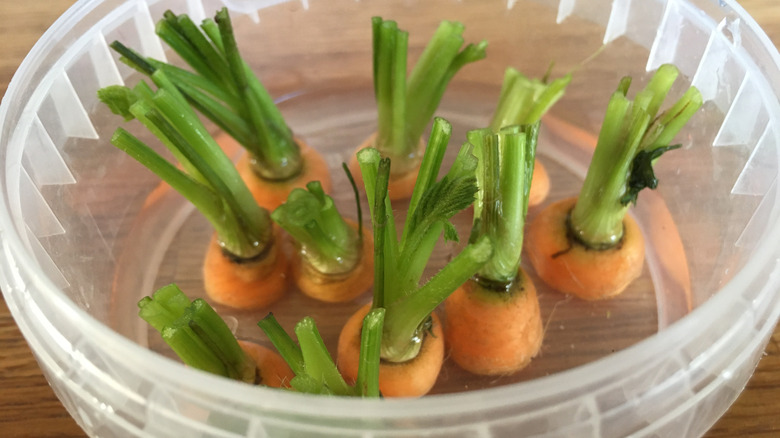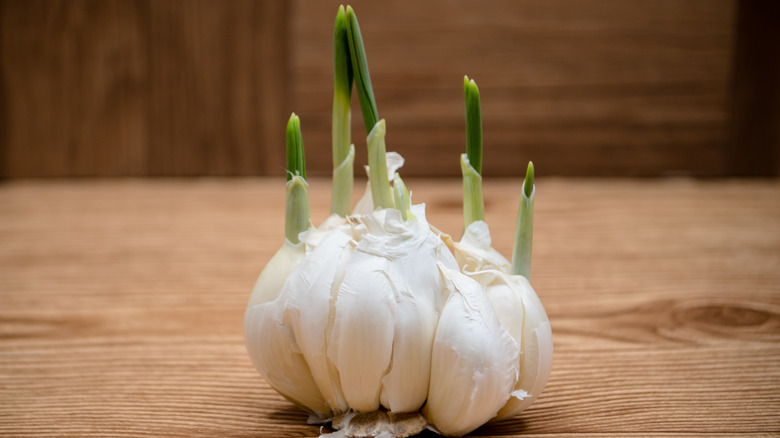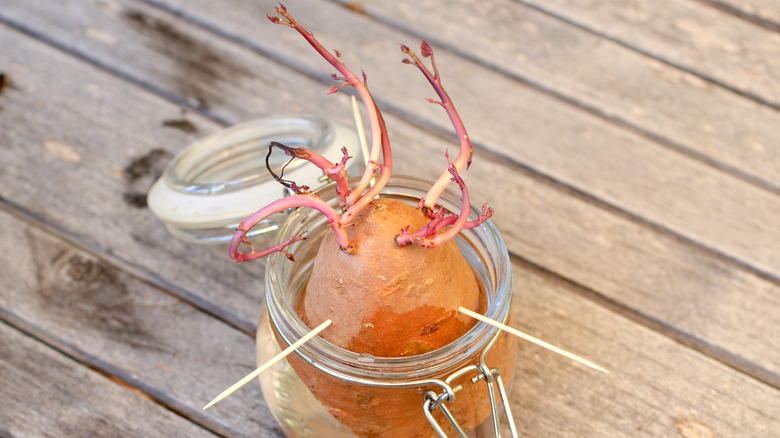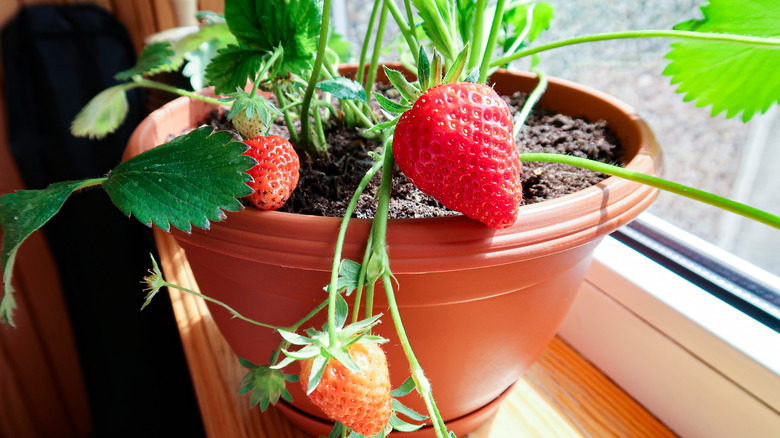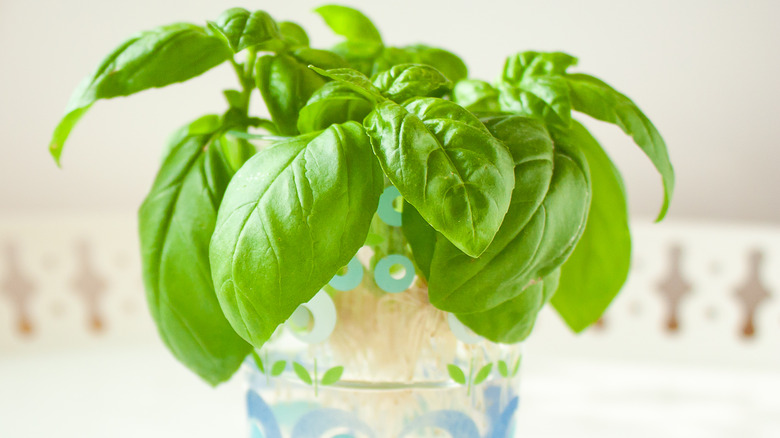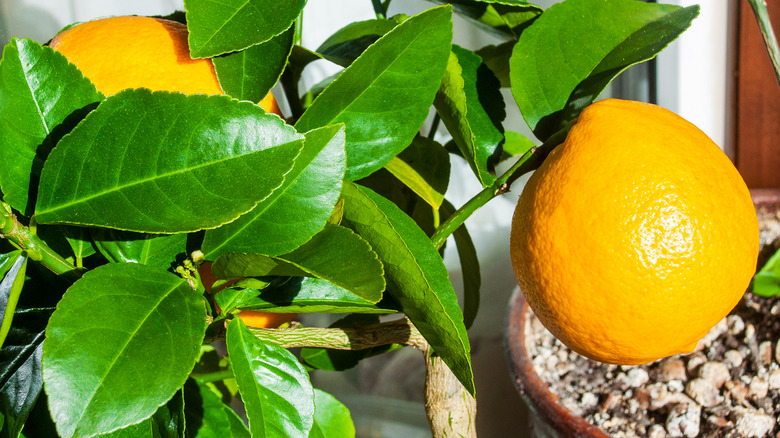11 Foods You Can Regrow From Kitchen Scraps
Every fresh vegetable at the grocery store is alive. It may be strange to think about, but it's completely true. From lettuce to blueberries, fresh produce is so alive that it even responds to day and night cycles, meaning that properly storing vegetables will keep them healthy for human consumption and even help them resist insect pests (via Current Biology). And like all living plants, they can be regrown. An easy way to do this is by rooting stem cuttings — placing freshly cut plant stems into water so that they can grow roots before giving them soil in which to grow whole new plants. With a little time and effort, a few leftover kitchen scraps can be regrown into an entire vegetable garden.
In 2023, even a thrifty family of four in the United States can expect to spend around $225 on groceries every week, and just a few homegrown herbs on a kitchen windowsill can help ease this burden. Of course, there are limits, and some kitchen scraps can't easily be regrown. Cilantro, for instance, doesn't usually work unless it already has roots attached. Many more, however, can grow perfectly well in little more than a glass of water. There's a range of good reasons to grow your own vegetables. It's healthy for you, it adds variety to your diet, it often yields a better flavor than store-bought produce, it's good for the environment, and most of all, it's fun. It's also a great way to reuse old glass jars and ramekins instead of throwing them out.
1. Green onions
Green onions are one of the easiest of all vegetables to regrow. Whether you're a complete beginner or an experienced gardener, it's very handy to have fresh green onions on demand so that you can use as much or as little as you need. They're usually sold with roots still attached, and these need to be chopped off before cooking anyway. If you leave an inch or two of the stem just above the roots, the onion stubs can be placed into water and left on a windowsill to regrow. Once they have some healthy roots, you can place them into soil so that they'll stay strong and healthy. Just make sure to change the water every week or so until then.
With green onions always handy, you could even try cooking a few new dishes. One option is pajeon, a kind of Korean pancake made with bunches of fresh green onions. Another is cong you bing, a pan-fried flatbread made with chopped green onions sometimes known as green onion pancake. In China, they're often found on sale as street food or served at breakfast time.
2. Mint
When it comes to herbs, there's probably nothing easier to grow than mint. A rugged, vigorous little plant, it'll often happily grow back with very little help. A few leftover mint stems from your kitchen can be placed into water and left on a windowsill, where they'll usually start to sprout new roots within a few days. The stems will have several nodes, which is where the plants grow both leaves and roots, so make sure at least one of these is below the water's surface. Once the stems have a few roots, they can be placed into soil and you'll soon have a healthy new plant. Just be wary of planting it in the ground. Mint will grow wild so easily, it can happily take over an entire garden. The plants do best in wet conditions, where they're unlikely to dry out.
With proper care, you'll soon have entire handfuls of mint to use in your kitchen. Far more than just a simple garnish or condiment ingredient, mint has all kinds of culinary uses. It can be added to keema curry or a warming pea soup. Mint is also great for making drinks, like this honey mint julep cocktail. If you have plenty to use, a generous handful of fresh mint is essential for making a refreshing pot of Moroccan mint tea. Dry mint just doesn't have the same taste.
3. Peppers
Although growing peppers from seed can be tricky, there are certain techniques to make it easier. Be sure to use fresh seeds harvested from a ripe pepper. They can be placed directly into soil, but don't bury them too deep. Keep the soil warm and damp, and don't let your peppers get too cold — they don't like temperatures below 50 degrees Fahrenheit. Adding some used tea leaves or coffee grounds to your soil will give your plants a boost. Just remember to be patient depending on which variety of pepper you're growing. While chiles can sprout within a week, hot peppers can take a month or longer.
After transplanting, bell peppers can be ready to harvest in just a couple of months, whereas hot peppers may take twice as long. Be sure to give them a spot with plenty of sunlight.
Note that while many plants have edible leaves, care should be taken with peppers. Some are edible and are used in certain Southeast Asian dishes, but others are poisonous. If you don't know exactly what kind of peppers you're growing, it's safer to pass on these.
4. Ginger
A ginger root is actually a rhizome, an underground plant stem that can grow new roots and shoots. In other words, ginger was made to regrow. Pick a healthy piece of ginger (not too dry, damp, or soft) and look for any spots where the root is already trying to grow — these look like little horns. Slice them off with a small piece of root, leave them for a day so that the cut edges will dry, and plant them in soil.
Ginger likes warm climates but can also grow well indoors. It can take up to 10 months to grow a good-sized ginger root; ginger planted in spring is usually ready to harvest by winter. The good news is, if you're growing it at home, you don't need to wait. Ginger leaves are also edible and can be used as an herb. They have a milder flavor than the root and go nicely in sautés and stir-fried dishes. Be warned, though — these leaves can be quite tough, so it's best to chop them finely with a sharp knife before adding them to your cooking.
5. Bok choy
Bok choy is a leafy Chinese vegetable with thick white stems and a flavor somewhat like spinach. It goes excellently in a good stir-fry. It is usually sold with the base of the plant still attached. This part is tough and unpalatable, so it's often chopped off before cooking. Instead of throwing these away, bok choy bases can be regrown with a little work. Simply leave the base, stem side up, in a bowl of warm water on a windowsill for a few days and it should start to grow. The old outer stems will start to die away (don't worry, this is normal), and new leaf shoots will start to grow out from between them. After seven to 10 days, carefully place your bok choy in some soil and keep the soil from drying out.
A similar trick works with several other kinds of leafy vegetables, as long as they're sold with part of the thick base stem still attached. Among others, cabbage and celery can easily be grown back using the exact same method. The most important thing is to make sure your vegetables get plenty of light. To grow healthy, they need several hours of natural daylight every day. Your plants will also need plenty of space to grow, so be careful not to plant them too close together.
6. Carrots
Unfortunately, there's no way to regrow full-size carrots from kitchen scraps, at least not directly. Carrot greens, however, grow back very easily. You don't even need to keep very much of the carrot, as long as you have a little of the root remaining. Just place freshly removed carrot tops in some shallow water, not quite enough to cover them completely, and leave them somewhere sunny — if your carrots came with leaves, trim these away to make space for new ones. They should soon grow some new roots and start to send up some fresh green leaf shoots.
Once your carrot tops grow a good amount of thin, white roots, you can take them and put them into some soil. While these will never produce any actual carrots, they'll eventually grow clusters of tiny white flowers. A single plant will produce 1,000 flowers, each yielding a seed that can be grown into a healthy new carrot plant. With good conditions, carrots are fairly quick to grow, being ready to harvest in as little as 60 days.
In the meantime, the carrot greens can also be eaten. You can use them as a pot herb, like parsley, adding a little to a salad or using it as a garnish. Some people even enjoy making carrot greens into a side dish all on their own, sautéing them in olive oil with some red pepper and garlic. And speaking of garlic...
7. Garlic
A single garlic clove can grow back an entire garlic plant, complete with its own bulb. It's as simple as putting the cloves directly into some soil and just leaving them to it, though this can take a little time — garlic needs around six months to grow a good-sized bulb. The plants don't mind cold weather, and the cloves are usually planted in the fall and left to grow through the cold months. Be advised that experts recommend that you shouldn't plant imported garlic; locally grown garlic will grow healthier.
Fortunately, there's no need to just wait for your garlic to grow full bulbs. Green garlic is a lot like scallions and tastes very good in all sorts of dishes. Its flavor is similar to that of garlic cloves but milder, so it can make a great pesto and work well in soups. With a distinctive flavor all its own, you may find yourself keeping a pot of green garlic on your kitchen windowsill to chop and throw into your cooking whenever you need it.
8. Sweet potato
Sweet potatoes aren't really potatoes at all. These tasty root vegetables are actually part of the morning glory family of plants, so they tend to grow long, trailing vines with attractive ornamental flowers. Regrowing a sweet potato is easy if you know how, but it's a little more complicated than just putting it in the ground. Chop the root in half and use toothpicks to keep it suspended in water without resting on the bottom of the container. It should soon start to grow small reddish sprouts. These are known as slips, and they can be carefully teased away from the sweet potato and placed in a different container of water until they grow roots. Then, they can be transferred into some soil.
Sweet potatoes should be ready to harvest within about four months. In the meantime, you might be able to enjoy some nice flowers. The leaves of the sweet potato plant are also edible and are a good source of vitamins A and C. A word of caution, though: Sweet potato leaves are also high in oxalates. These compounds can be harmful in large amounts, so it's best not to eat sweet potato leaves too regularly.
9. Strawberries
Most people enjoy a bowl of fresh strawberries or a tasty strawberry smoothie. Anyone familiar with the berries will also be familiar with the seeds, which the berries wear on full display on their skin. However, growing strawberries is a bit more of a long-term project than other fresh produce. To germinate properly, the seeds need to go through a process called cold stratification — essentially, this means that they need to experience winter conditions. Therefore, the seeds must be "tricked" by putting them into the refrigerator for a month.
It takes some time before you'll get any fruit from your strawberry plants — they won't grow berries their first year — but the results are worth it. With plenty of bright sunlight, homegrown strawberries often have more flavor than store-bought ones. The good news is, these plants are perennial and winter-hardy, meaning that with proper care, they'll keep giving you fruit year after year. Strawberries can also grow well indoors in pots or hanging baskets. Just make sure they get at least six hours of sunlight every day.
10. Basil
Basil is slightly more stubborn than mint, but it's still fairly easy to grow from cuttings – a single stem will grow roots when left in water and given a good amount of light. Grocery stores often sell it in pots already, but some gardeners like to buy potted basil, take several cuttings from it, and grow their own basil plants. To give your cuttings the best chance, remove the leaves at the bottom of the stem so that they are not underwater but make sure that one of the nodes is. Basil likes heat and plenty of light — at least eight hours every day — so if you're keeping it indoors, be sure to choose your sunniest window.
Basil is famous for its sweet, savory flavor, and there are a variety of things to do with fresh basil leaves. A good supply of them at home will give you lots of freedom to experiment. Besides the obvious ideas like putting them in salads or Italian dishes, basil leaves can be used to infuse olive oil or even make ice cream. Basil tastes good with strawberries too, and some strawberry basil iced tea can make a delightfully refreshing summer drink.
11. Lemons
Among all the everyday fresh produce you can regrow, lemons may take the most patience. Grown outdoors, a lemon tree can take up to six years before it starts to produce fruit (a tree grown indoors will be faster). If you like the idea of having your own lemon tree, the seeds are usually quite easy to germinate. Be advised, though, that the seeds may not yield quite the same lemons as the fruit they came from. Thanks to genetics, no two homegrown lemon trees are exactly alike. A lemon tree can make a very good houseplant and will enjoy being placed in front of any bright window. Growing them indoors can be a good option in many places because they don't like the cold and can be harmed or even killed by frost.
Though you may have to wait a while for the fruit, the leaves are also edible. They're too tough and waxy to eat themselves, but they can be used in a similar way as bay leaves. Lemon leaves are fragrant, with a sharp, slightly spicy aroma, and can add depth to a variety of dishes. In fact, they're a necessary ingredient of some Mediterranean-style dishes, including the leaf-wrapped polpette con foglie di limone or oysters wrapped in lemon leaves. With lemon leaves being otherwise difficult to obtain, the best way to try recipes like these is to grow your own.
